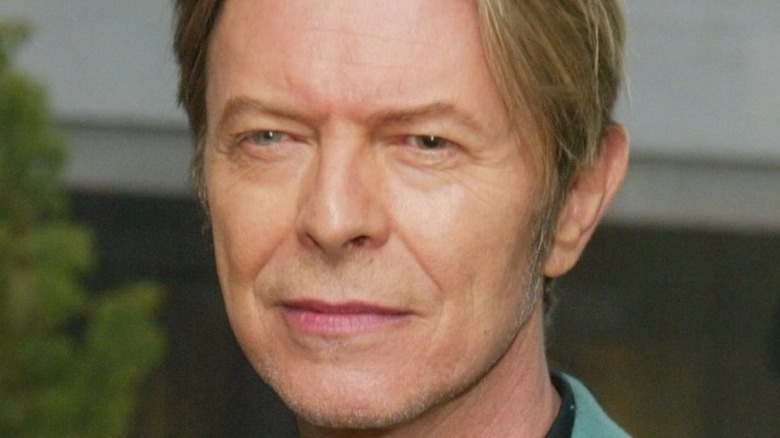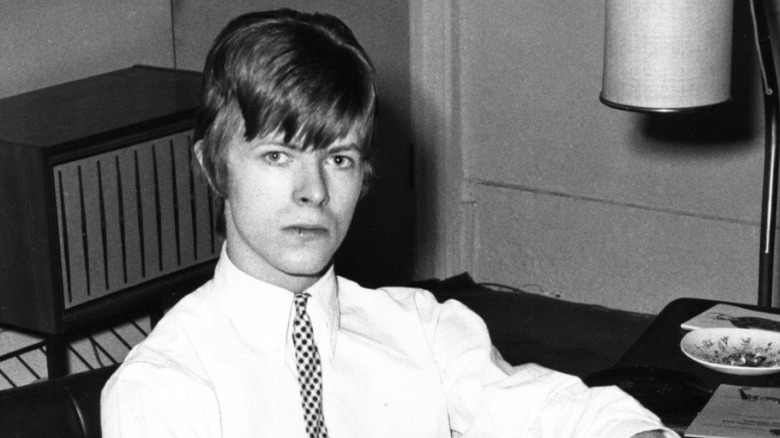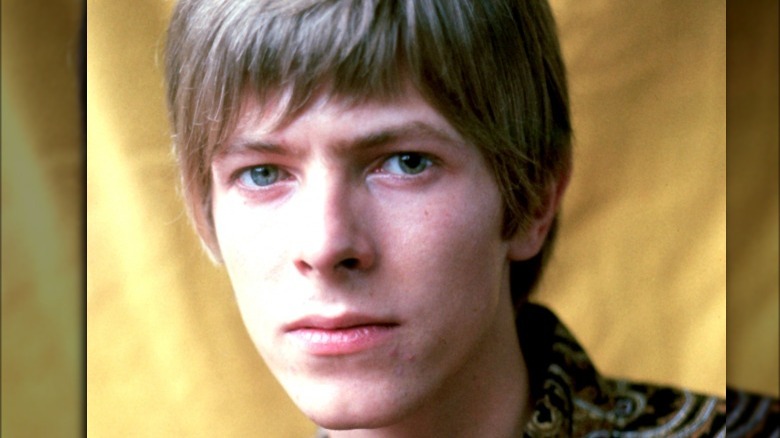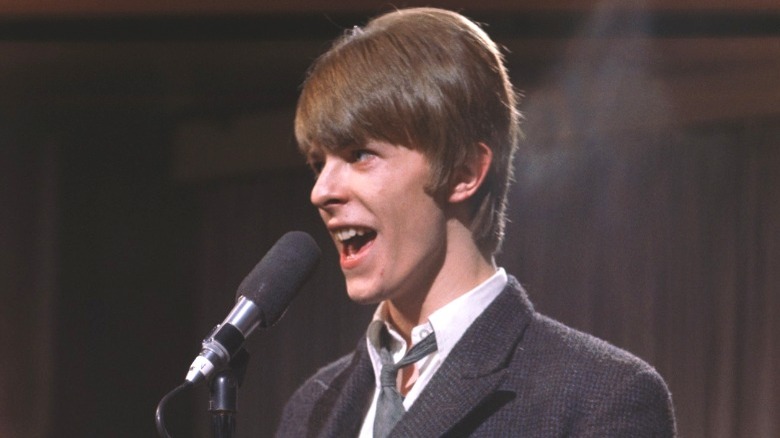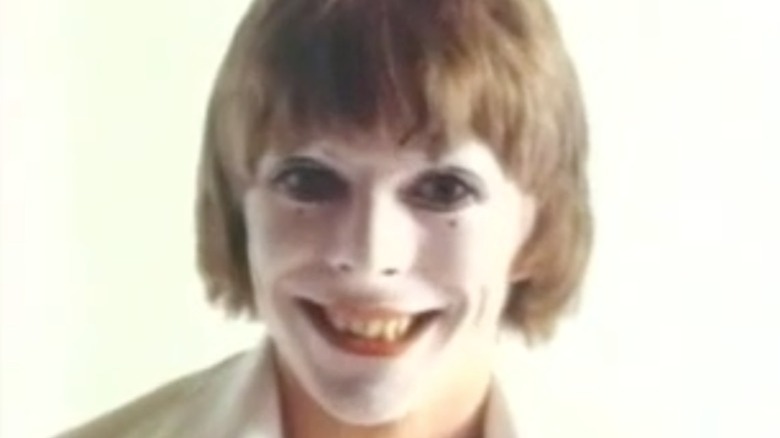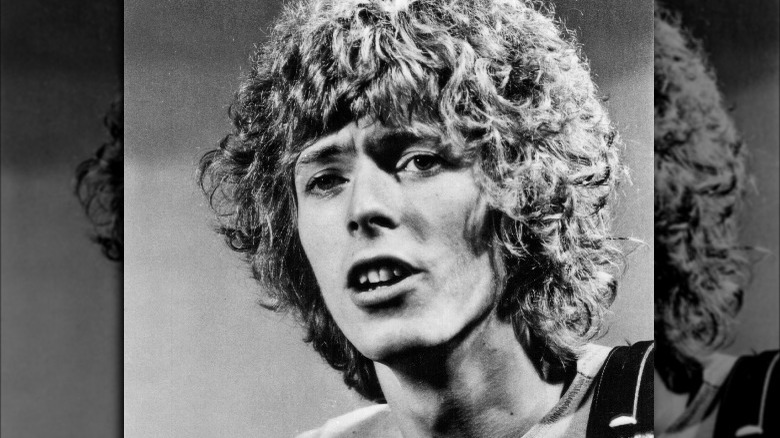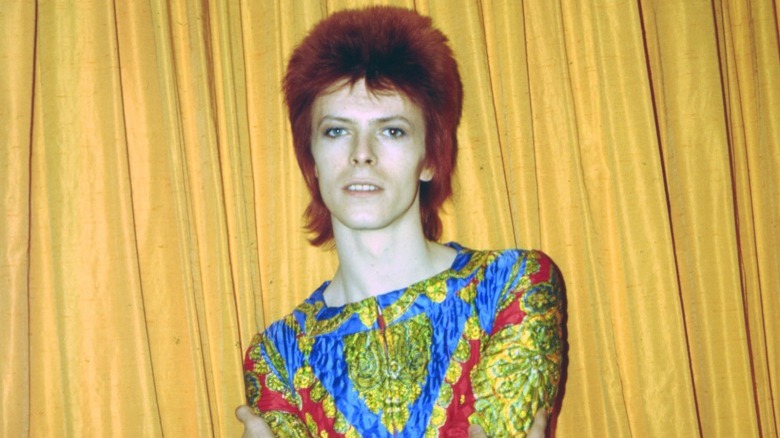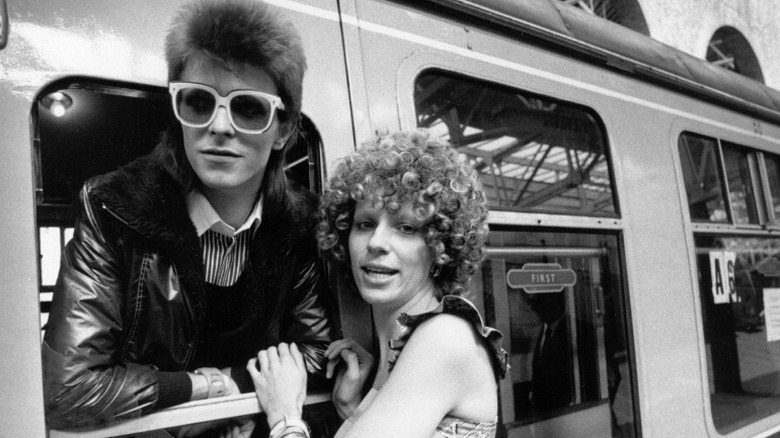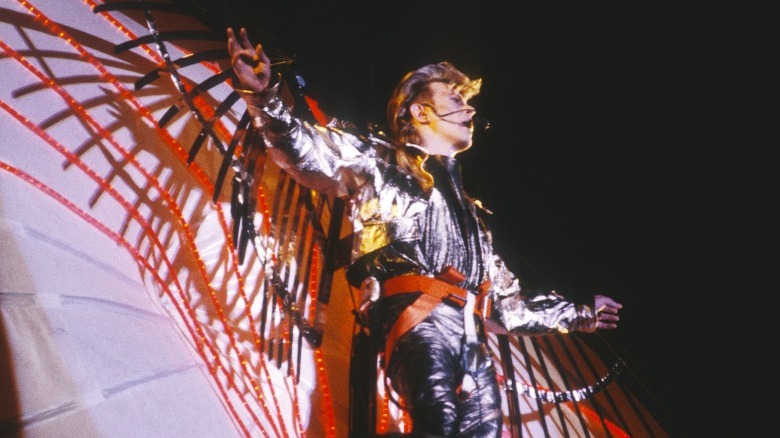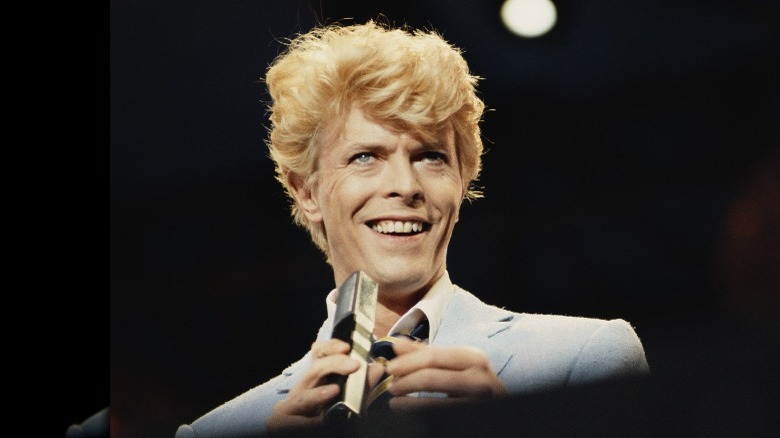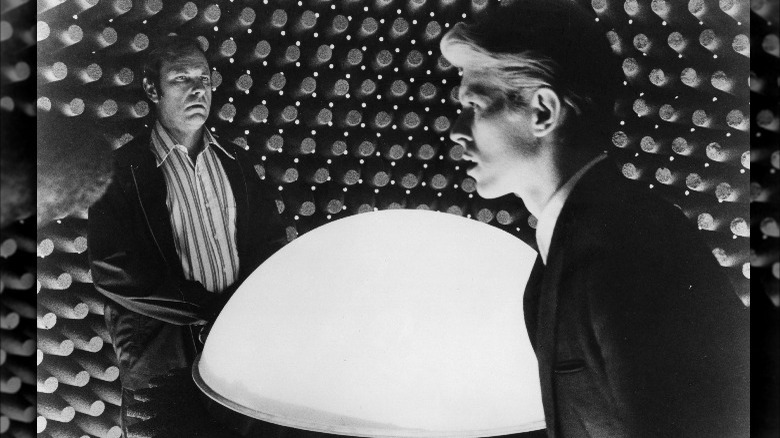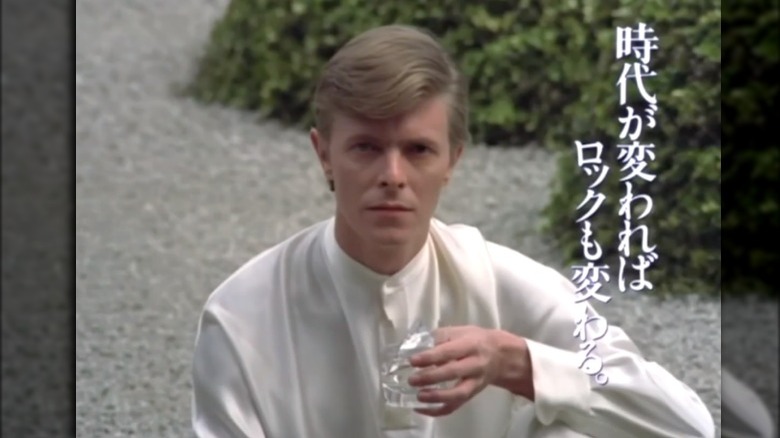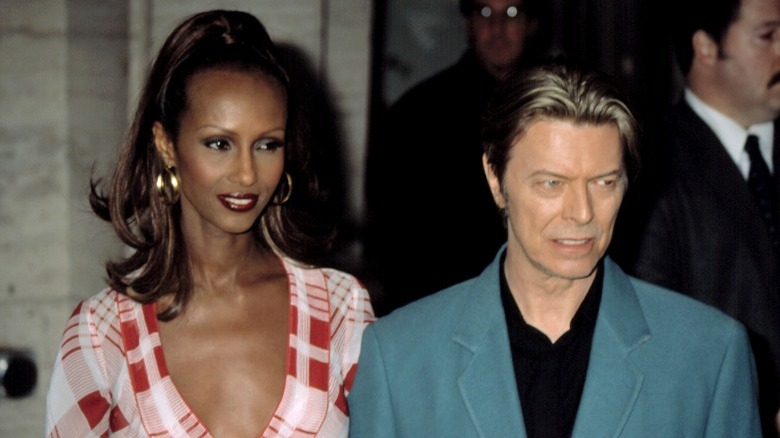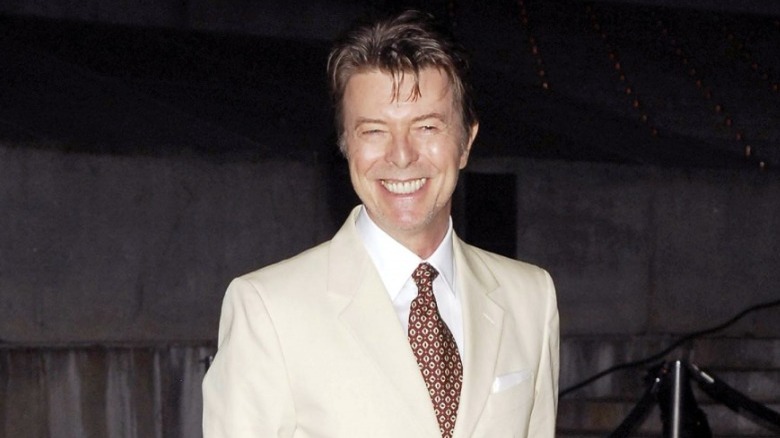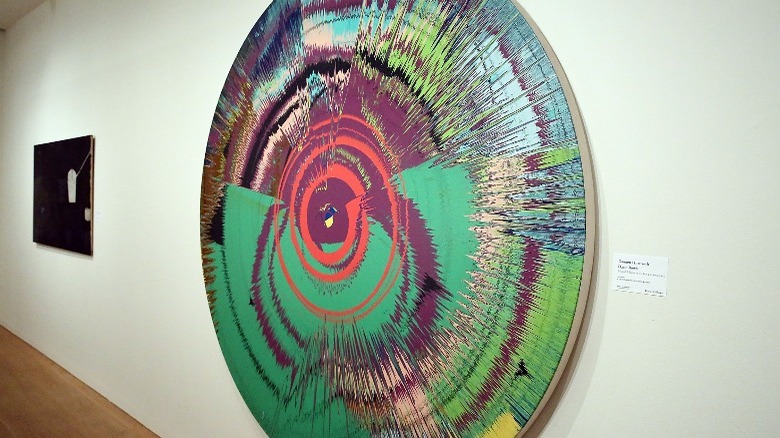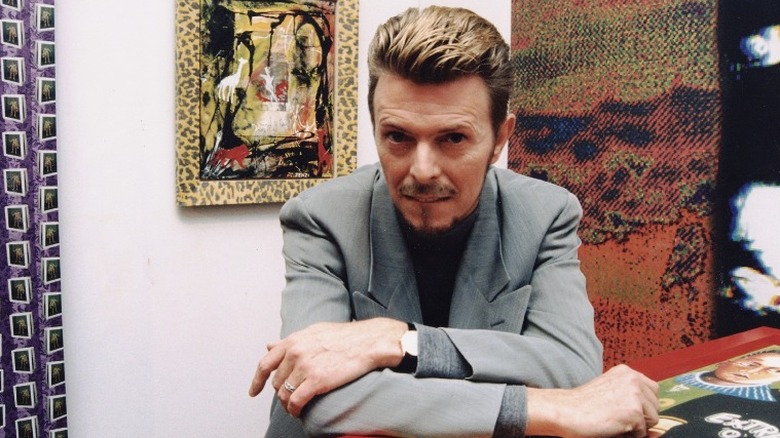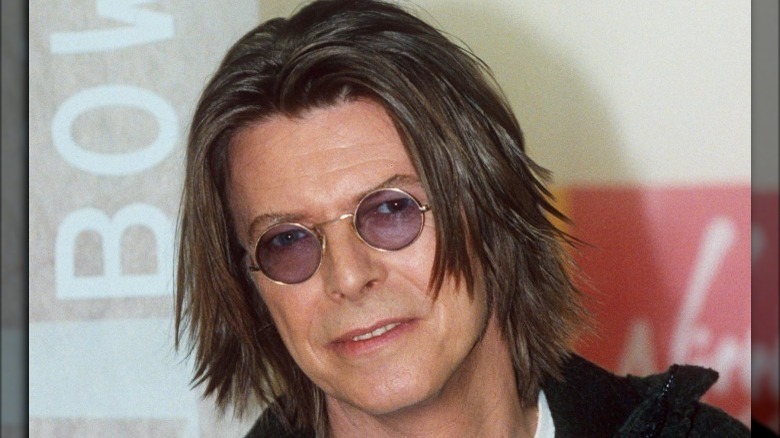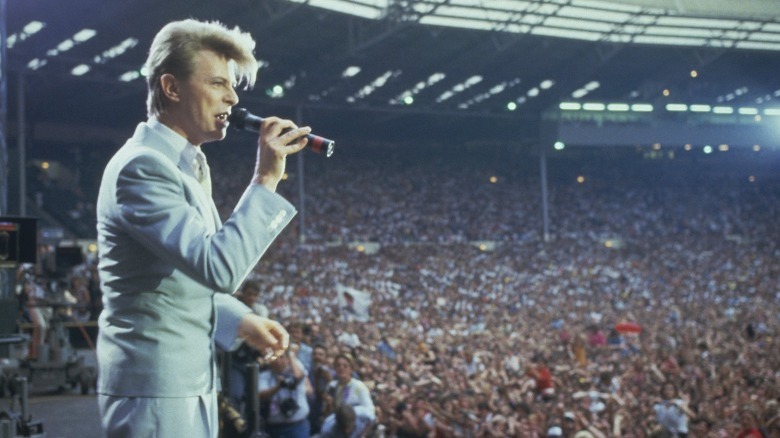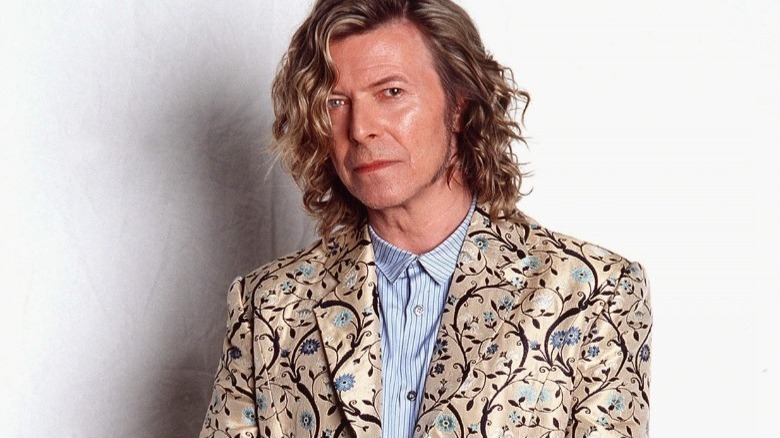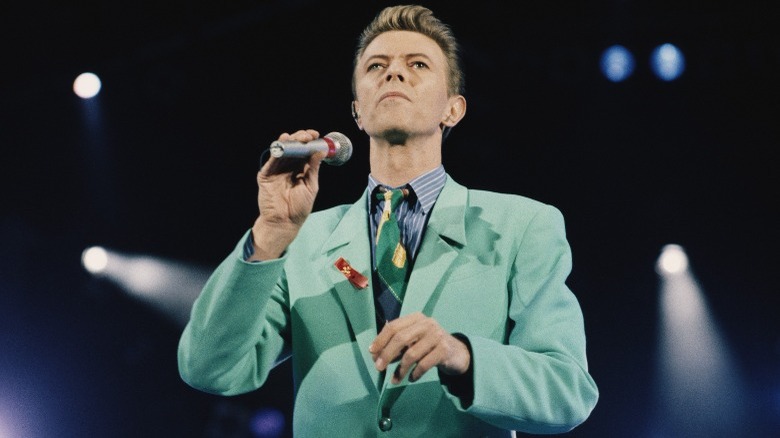David Bowie's Net Worth: How Much Was The Singer Worth When He Died?
David Bowie was many things — most iconically a rockstar. But throughout his storied life, he was also an actor, a mime, an avid art collector, an internet pioneer, and a savvy businessman. These varied avenues of success led him to an impressive fortune. Yet, even as his income multiplied, he wasn't a careless spender and believed money should be put back into creative work and business ventures. In a 1999 interview on BBC "Newsnight," he explained, "The majority of the money that I make I plow back into some new project or other. ... I'm not a buyer of stuff. I do tend to regard money as the oil to get other things going."
Perhaps it's no surprise, then, that when the legendary multi-talent died in 2016, he boasted an impressive fortune. Let's take a look at how David Bowie earned his wealth by going into the details of his career choices and how he took advantage of financial highs and overcame monetary lows.
David Bowie went from humble beginnings to promising young artist
Before David Bowie was David Bowie, he was David Robert Jones, born into a working class family in the London suburbs. His father, John, failed at several showbiz ventures and became a porter in a hotel before settling permanently into a job at a British charity for children. His mother, Peggy, met his father while she was waitressing at the Ritz Cinema.
David mostly spent his childhood in the clutches of a quiet, mundane world, where he longed to get out. In the documentary "David Bowie: Finding Fame," Dana Gillespie, a girlfriend from his youth, recalled going home with Bowie one day, and she described the atmosphere in his parents' house as "soulless." She said, "Once [his parents] had gone out, [David] said, 'Whatever it takes I want to get out of here. I do not want to live like this.'"
As documented in "David Bowie: The Oral History," the artist said, "[When you come from] suburbia you find yourself in the middle of two worlds. There's the extreme values of people who grow up in the countryside and the very urban feel of the city, and in suburbia, you're given the impression that nothing culturally belongs to you, that you are sort of in this wasteland. I think there is a passion for most people, a sort of curiosity about them to escape and get out and find who one is..."
Bowie did just that, finding his calling in the midst of the booming London music scene of the 1960s as he began to write songs and perform with bands.
He made ends meet by scrubbing kitchens
When David Bowie was first trying to make it as a musician, he struggled to stay afloat financially and took various cleaning jobs to get by. The documentary "David Bowie: Finding Fame" includes a soundbite of Bowie recalling those early struggles: "I remember there was this endless period where I was scrubbing out people's kitchens, I know I did that. Anything to pick up a few dollars. I needed something that didn't tie me down in any way so if an audition came along or whatever I'd be free to do it."
It's hard to imagine the man who would become Ziggy Stardust, the rockstar from outer space, cinderella-ing his way through messy kitchens in London, but according to Francis Whately, director of "David Bowie: Finding Fame," it remained a steady gig for him throughout the '60s. Whately told NME, "One of his friends in The Riot Squad told us that David would come in, be very nice to his parents, and help his mum with the washing up."
His first artistic endeavors were financial failures
David Bowie's first few singles were released under his birth name, David (Davie) Jones, and didn't get him much attention. Neither did his 1967 debut album as David Bowie. The album never made it past 125 in the U.K. charts, and as a result, the Deram Records label dropped the young artist in 1968. In the documentary "David Bowie: Finding Fame," album producer Mike Vernon said, "It was pretty strong competition. ... Frankly, Bowie didn't stand a chance, really, and that's why the record, I'd guess at the time, completely flopped. I mean it didn't really do any business at all."
Tony Hatch, producer of some of the musician's early singles, recalled, "The record company decided it didn't matter what I was going to make with David. They were losing faith. His songs — they weren't good enough to actually capture everybody's imagination. You know, it still isn't that unique Bowie magic." That is, not good enough yet. At this point in time, Bowie was still a young, developing artist.
Later in life, Bowie looked back on his first album with regret, calling it "cringey," adding, "I haven't got much to say about that in its favor. ... Lyrically I guess it was striving to be something, the short-storyteller. Musically, it's quite bizarre. I don't know where I was at" (via Paul Du Noyer's "In the City: A Celebration of London Music").
He almost gave up music to become a monk, then a mime
After the failure of his first album, Bowie considered becoming a Buddhist monk. He told Billboard in 1996 that he had "wanted to become part of the order and go up to a Tibetan monastery in Scotland" after joining London's Tibet Society.
After his guru advised against it, Bowie was drawn into the world of miming (which would eventually lead him back to music). He became fascinated with the art form after meeting mime-choreographer Lindsay Kemp, who told the CBC, "Just before I met David, he was planning on giving up music altogether. I mean, he was feeling very disillusioned." Kemp became Bowie's teacher and lover for a brief time. He confided that Bowie "fell in love" with his "circus world." Even after what Kemp called their "short-lived affair" ended, he and Bowie remained collaborators, well into the Ziggy Stardust years.
In 1967, Bowie helped create the mime show "Pierrot in Turquoise" with Kemp, writing music for the production. The show premiered at the Oxford New Theatre and later moved to the Mercury Theatre in London. Though surely learning mime and performing in a steady theatre play must have helped develop Bowie's performance skills, his new career was not a moneymaker. "I think [the Mercury Theatre] sat 120 seats so we didn't make much money. Need I say more? Nobody came at all," Kemp said in "David Bowie: Finding Fame." In 1970, a televised adaptation of the play aired in Scotland.
Bowie also took his mime act on tour with T-Rex during this time, though audiences were not impressed.
How Space Oddity skyrocketed David Bowie to fame
With a new record label and a pile of newly-written songs, David Bowie began recording his second album in 1969. One of those songs, "Space Oddity" — inspired by Stanley Kubrick's "2001: A Space Odyssey" — would become his first taste of long-awaited success. Knowing that space travel and moon landings were on the public's radar that summer, the record label rushed the single's completion to coincide with the Apollo 11 mission, releasing it five days before the launch.
The moon landing undoubtedly helped the commercial success of the song, and a big break came when the BBC played it during their Apollo 11 coverage. Bowie was thankful for the usage but also felt it was inappropriate for the occasion. In Bill DeMain's book, "In Their Own Words: Songwriters Talk About the Creative Process," Bowie explained, "I'm sure they really weren't listening to the lyrics at all. ... It wasn't a pleasant thing to juxtapose against a moon landing. Of course, I was overjoyed that they did. Obviously, some BBC official said, 'Oh, right then, that space song, Major Tom, blah blah, that'll be great.' 'But he gets stranded in space, sir.' Nobody had the heart to tell the producer that."
Though the song was less of a hit in the United States, it rose to number five in the U.K. Charts and gained Bowie recognition in Britain. "When he had the big hit with 'Space Oddity,' that's where the change came, where he started seeing himself as a star," producer Tony Visconti said in "David Bowie: Finding Fame." However, that newfound fame did not immediately lead to wealth.
Bad contracts and drug addiction led to financial lows
Despite his "Space Oddity" success, David Bowie was still struggling financially in the early 1970s. He was saddled with a bad contract with manager Tony Defries, who took 50% of his earnings (via Billboard). According to Christopher Sandford, author of "Bowie: Loving the Alien," Bowie was living on "loose change" despite high record sales.
Sandford further explained, "Of RCA's initial advance of $56,250, Bowie saw just £4000. The rest was held by Defries ... In late 1971 Bowie and his wife were living on £400 a month, enough to periodically pay the rent, but modest by the illusory standards of New York. Even when 'Hunky Dory' was released just before Christmas, its first quarter sales barely reached five thousand." Later, Bowie said he had been "f***ed royally" by the whole situation. He finally got out of the deal with Defries in 1975, though the manager retained partial rights to Bowie's early catalogue until the late '90s (per Billboard).
The rockstar also struggled with cocaine addiction throughout the '70s, and surely, a portion of his income was spent on the drug. "I had a small handful of what one might call normal friends," Bowie said, "The rest were dealers. It was extremely unhealthy" (via The Sun). He added that he didn't "fully kick" the habit until the mid-'80s.
If you or anyone you know is struggling with addiction issues, help is available. Visit the Substance Abuse and Mental Health Services Administration website or contact SAMHSA's National Helpline at 1-800-662-HELP (4357).
David Bowie's first marriage ended on these terms
In 1970, David Bowie married 19-year-old Angie Barnett (turned Angie Bowie). Angie has often been credited for helping create Bowie's alter-ego, Ziggy Stardust, and for establishing his glam rock, androgynous image of the '70s. After ten years, however, their polyamorous marriage had became more and more strained due to drug use, and they went their separate ways.
The star didn't exactly break the bank during the divorce. Angie received £500,000 in the settlement and willingly left David Bowie with full custody of their son, Duncan Jones, who remained estranged from his mother, calling her a "corrosive person" in an interview with The Sun.
Angie seemed to view her marriage with Bowie as more of a business agreement than a romantic one. She told The Evening Standard, "The divorce was bullsh*t because it wasn't a real marriage anyway. I thought £500,000 for a stupid marriage to get a work permit wasn't bad. What I was p*ssed about was my half of managing him because I had worked so hard."
But it's clear that Angie always believed she deserved more out of the ten-year marriage and divorce, claiming to the Daily Mail, "Pictures of us together were destroyed. [Bowie] would never let it be acknowledged what I had done for him. I was given a kiss off, whacked financially."
Live shows equaled lucrative earnings
Throughout his life, a large portion of Bowie's income came from touring. His 1987 Glass Spider Tour was one of the highest grossing tours of all time, bringing in $86 million (which would be equivalent to $198 million today).
Despite the fact that it was a big moneymaker, the tour faced heavy criticism, and according to Rolling Stone, it is often cited as "one of the worst things he ever did." The infamous tour was sponsored by Pepsi, which allowed for a huge budget to begin with. While some questioned his decision to opt for a multi-million dollar deal with the soda company, he stood by the decision, telling the Orlando Sentinel, "It's a business device that allows me to put on a better show."
The staging included a giant spider, dancers, and other props that were seen by many as too over-the-top — an arguably odd criticism for an artist who was famous for being outlandish. But the numbers don't lie; the tour was clearly a good business move and paid off financially.
Which Bowie albums brought in the most income?
It's not surprising that many of David Bowie's albums were big moneymakers. While his '70s albums like "The Rise and Fall of Ziggy Stardust and the Spiders from Mars" and "Aladdin Sane" are among his highest grossing records, his most commercially successful album was 1983's "Let's Dance," which sold 10.7 million copies. Producer Nile Rogers explained to Uncut (via NME), "Diehard Bowie fans act like those records of the '70s — 'Ziggy Stardust,' 'Pin Ups,' and the others — were these massive records, but they weren't. ... They were great artistic products, but they weren't 'Let's Dance.' We've got to be honest, the numbers tell the story."
Bowie's '80s mainstream success began after he walked away from RCA and signed a $17 million contract with EMI in 1983 (per NME). "Let's Dance" was released that same year and became the fastest-selling record for the label since The Beatles' 1967 "Sgt. Pepper's Lonely Hearts Club Band" (which, ironically, had been released on the same day as Bowie's debut flop album).
His final album, "Blackstar," which was released only two days before his death in January 2016, was also a massive success, outselling his older hits, and it became his only album to ever reach number one on American charts.
His acting career was more than just a side gig
While David Bowie was never a full-fledged movie star, he did have an extensive acting career, and several of his on-screen projects undoubtedly contributed to his lifetime income, from Broadway to starring roles in cult classics and guest appearances on TV shows.
Bowie's acting credits reveal his versatility as an artist. His first starring role came in 1976, when he appropriately played an alien in the sci-fi film "The Man Who Fell to Earth." Other memorable roles include his 1996 portrayal of Andy Warhol in "Basquiat" (a biopic of artist Jean-Michel Basquiat), his part as a sensual vampire in 1983's "The Hunger," and his role as Pontius Pilate in "The Last Temptation of Christ" in 1988. He also made an unforgettable appearance in David Lynch's "Twin Peaks: Fire Walk with Me" as agent Philip Jeffries.
But perhaps his most celebrated role is that of Jareth The Goblin King in Jim Henson's 1986 cult classic, "Labyrinth," for which he wrote, produced, and sang many songs. He could also excel at comedy, as proven by "The Linguini Incident" and his cameo in "Zoolander."
Though not a starring role, his biggest box office hit was 2006's "The Prestige," in which he portrayed scientist Nikola Tesla. The film, which centered around 19th century magicians, grossed nearly $109.7 million worldwide.
Beyond screens, he also dabbled in the stage, most notably starring in "The Elephant Man" on Broadway in 1980.
David Bowie was a frequenter of adverts
In the 1970s, at the height of his glam rock era, David Bowie wasn't the type of artist who was willing to "sell out." Though he had appeared in a 1960s popsicle ad before he was well-known, it wasn't until 1980 that he starred in his first commercial as a celebrity — and even then, it was an artsy ad for shōchū (an alcoholic beverage) that aired in Japan.
But after his 1983 chart-topper "Let's Dance," Bowie fully embraced his place in mainstream culture and appeared in several advertisements throughout the remainder of his career, from a 1987 Pepsi commercial with Tina Turner to a 2013 Louis Vuitton advertisement.
Did Bowie do it for the money? In "Selling 'David Bowie': Commercial Appearances and the Developing Bowie Star Image" (from The Oxford Handbook of Music and Advertising), Katharine Reed notes, "At this time, Bowie was wildly popular and financially successful on a scale he had not achieved before, thanks to the success of hits 'Let's Dance' (1983) and 'Tonight' (1984); this high-profile advertising work was a strategic choice rather than a strict necessity." She continues by stating that he "embraced the 'commercial' label" because "he was rebranding himself as commercial."
Even if he didn't do it for the money, one can only speculate the exorbitant amount of money he did earn from his advertising appearances.
His second marriage was to a fashion icon
In 1992, David Bowie married the Somali-American supermodel Iman Abdulmajid. Iman is a successful businesswoman and was a fashion icon long before her marriage with Bowie. She started her own cosmetics company in 1994 called IMAN Cosmetics, "a beauty company that created the first cosmetics and skincare collection designed for all women with skin of color," according to the company's website.
She has also written several books, and as a model, inspired some of the biggest names in the fashion industry, including Yves Saint Laurent, Donna Karan, Calvin Klein, and Versace (per the IMAN Cosmetics site). Today, her net worth is estimated to be $120 million.
During David Bowie and Iman's 24 years of marriage, the couple aimed to stay private about their relationship and their family in order to avoid the prying eyes of the public and fans. In an interview with Net-A-Porter a few years after Bowie's death, Iman said that while she sympathizes with her husbands' fans, she wants others to understand that her grief and pain is a more intimate experience, explaining, "They have lost someone they look up to; we have lost a husband and a father."
David Bowie's major contribution to the world of finance
In 1997, David Bowie hatched an innovative plan with music banker David Pullman to sell $55 million worth of "Bowie Bonds" to Prudential Insurance Company Of America (via Forbes). The revenue from 286 of Bowie's songs served as collateral for the bonds, which would pay a 7.9% coupon and mature in 10 to 15 years.
The "Space Oddity" singer then used part of this upfront payment to buy the remaining portion of his copyrights and recording rights of earlier work from his former manager Tony Defries (the guy he made a bad deal with in the '70s), which allowed him to take control of his entire catalog of music. He was finally freeing himself from the bonds of an old contract. He also felt passionately that his family should inherit the rights to his creative work, and "Bowie Bonds" turned that dream into a reality.
At the time, this concept was deemed "revolutionary" (via the Los Angeles Times) and clued Wall Street in on the potential of an asset-backed bond. Though in today's world, where music sales are far from what they once were, an artist wouldn't be able to pull off such a bold financial move.
He possessed a pricey art collection
David Bowie was an avid art collector. In fact, in a 1999 BBC "Newsnight" interview, he claimed, "The only thing that I buy — addictively and obsessively, probably — is art." Bowie's collection, which was sold after his death, included paintings and sculptures from a variety of famous artists whose works are worth more than a pretty penny. A Jean-Michel Basquiat painting, titled "Air Power," was one of the most notable pieces in the collection and sold for $8.8 million, double the estimated price.
The painting "Head of Gerda" by Frank Auerbach was one of Bowie's favorite, and he reportedly once said "I want to sound like that looks" (via NME). As such, it was another one of the biggest sales in the auction, bringing in over $5 million.
The collection also included works by painters Patrick Caulfield, Damien Hirst, and Harold Gilman, as well as Memphis Design furniture by Peter Shire and Ettore Sottsass.
The art he collected over the years sold for a total amount of $41.1 million dollars in 2016, a large gain, to say the least.
His side talent led to a publishing business
More than just a collector of visual art, Bowie was also a painter in his own right (he's pictured above with some of his original work). In the 1990s, he became further involved in the visual art world as an art critic and publisher. As a board member of the British art magazine, Modern Painters, he was a frequent contributor, interviewing artists and critiquing their work.
In 1998, he started his own independent art publishing house called 21 with Modern Painters editor Karen Wright. 21 aimed to publish art books that would appeal to the public without pretension. In an interview with ARTNews, Bowie explained, "Everything was either art at an academic level or so dense with art-talk that it excluded 90 percent of the reading market." The publishing house likely didn't bring in much money, however, since Bowie said, "As long as we break even at year's end, I think we'll be happy." 21 most famously (or notoriously) tried to pass a fictional story off as a nonfiction biography in an elaborate hoax.
David Bowie's pioneering internet ventures
Saying David Bowie was ahead of his time is an understatement, especially when it comes to how he viewed the internet. Seeing the opportunity the World Wide Web could provide for artists to build a significant presence and the potential for exploring new mediums in art, Bowie launched his own internet service provider called "BowieNet" in 1998.
The provider and platform pioneered many features that would later become commonplace in social media and streaming services, including exclusive internet streams for subscribers and chat boards for artists to directly interact with fans.
In 1999, he became the first major artist to sell an album digitally, releasing "hours..." online as an mp3 download before it was sold in stores. In an interview with BBC "Newsnight," the artist called the internet an "alien life form," making some strangely accurate predictions: "I think the potential of what the internet is going to do to society, both good and bad, is unimaginable. I think we're actually on the cusp of something exhilarating and terrifying ... it's going to crush our ideas of what mediums are all about."
The next step in his internet plan was creating an online bank called "Bowiebanc.com" in 2000, though some users were skeptical of online banking with a rockstar. MTV News reported that one fan said, "I will not join. It is too much. David should stick to art and let the [bankers] shuffle the money around." The bank didn't last long, and by 2006, "BowieNet" was no longer available as an Internet Service Provider, though it did remain for some time as an online portal for fans.
The Thin White Duke's charitable side
In an ideal world, gaining large amounts of wealth means committing to philanthropic responsibilities. For David Bowie, charity was certainly a focus. He gave a portion of his income and time to philanthropy, championing several causes throughout his career.
In 1985, Bowie performed at the charity concert Live Aid alongside Queen and other big acts. The event raised awareness about famine in Ethiopia.
Bowie and his wife, Iman Abdulmajid, were involved in HIV/AIDS activism and were consistent supporters of Keep a Child Alive, an organization that predominantly provides HIV/AIDS treatment and prevention for children affected by the disease. The couple also participated in the 1990 fundraiser Seventh on Sale, a "multi-day, multimillion dollar fundraiser for HIV/AIDS," according to Vogue.
According to Look to the Stars, Bowie also did philanthropic work toward ending poverty and hunger and helping "children affected by war." The long list of charities include 21st Century Leaders, Food Bank For New York City, Every Mother Counts, Save the Children, War Child, Whatever It Takes, and WhyHunger, just to name a few.
Is there real estate on Mars?
David Bowie wasn't the type of rockstar to own several mansions scattered across the globe. "I'm not really a house man, or a car man," he told BBC "Newsnight."
However, throughout his career, he owned properties in various countries, including a villa on the tropical island of Mustique that he sold in the '90s for nearly $5 million and a chateau in Switzerland that he later sold.
At the time of his death, he owned an apartment in SoHo and a home in upstate New York. He bought the Manhattan apartment in 1999 for $3.8 million, according to the New York Post. This apartment, where he lived with Iman and their daughter, Lexi Jones, was his predominant residence during his final years. Though there were rumors that he also kept a home in London, in 2012, the Evening Standard reported that Bowie said, "I'm in New York most of the year now. I leave only if work demands it. I've read the rumors about how I have houses elsewhere, but New York is it." The 5,000-square-foot apartment had four bedrooms and four bathrooms and sold in 2021 for almost $17 million.
The property in the Catskill Mountains was reportedly purchased in 2003 for $1,162,500. Bowie later built a home on the property, and it is allegedly the site of his final resting place. The home, which was located near the town of Woodstock, was gifted to his daughter, Lexi, after his death.
His will and lasting legacy
On January 10, 2016, David Bowie died from complications of liver cancer, two days after his 69th birthday and the release of his final album, "Blackstar." In a BBC "Newsnight" interview, Bowie stated that he sought opportunities to secure money out of fear: "Being [from the] working class, [I] always feel that there's never enough to leave my family so there's that kind of survival instinct."
He definitely had no need to worry. According to his will, he reportedly left much of his almost $100 million estate to be divided between his wife and children. 50% went to his wife, Iman Abdulmajid, 25% to his son, Duncan Jones, and 25% to his daughter, Lexi Jones. He also reportedly left $2 million to Corinne "Coco" Schwabb, his personal assistant of 46 years, and $1 million to Marion Skene, the nanny who helped raise his son.
His music, films, and projects will continue to bring in revenue for the estate and his family for decades to come. In fact, The Washington Post called Bowie's posthumous earnings a "career breakthrough."
In September 2021, Warner Music announced they were partnering with the Bowie estate to release a series of recordings from Bowie's catalogue. CEO Max Lousada stated on behalf of Warner Group (via Variety): "It's an incredible honor to have been chosen as the stewards of one of the most important and dynamic bodies of creative work in modern culture. The impact of Bowie's repeated reinvention and endless experimentation continues to resonate around the world."

